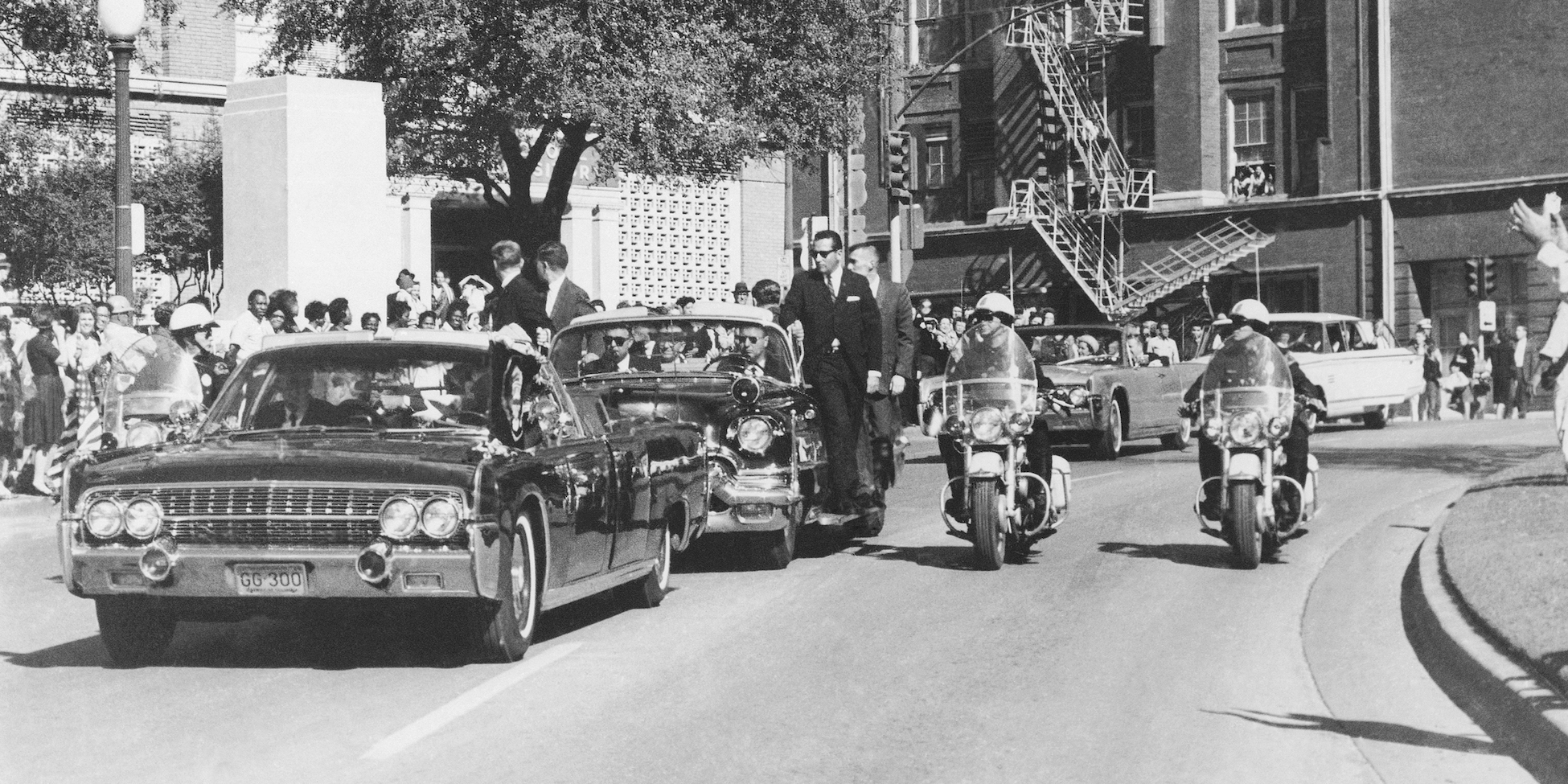President Donald Trump has allowed the release of a trove of documents connected to the 1963 assassination of President John F. Kennedy, and many hope that the documents will clarify some of the details in the Kennedy case that had previously led to speculation and conspiracy theories.
In conjunction with the release of the JFK files on Thursday, here’s a rundown of the most important moments on the day of the assassination:
Friday, November 22, 1963, 12:30 a.m.
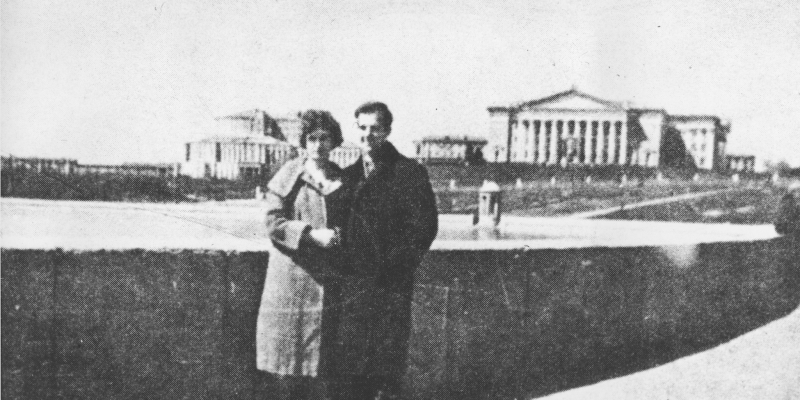
Lee Harvey Oswald and his wife Marina are not living together. While Oswald lives in a boarding house at 1026 N. Beckley Ave. in the Oak Cliff section of Dallas, Texas, Marina Oswald is living with Ruth Paine in Irving, Texas.
Unlike most weeks, Lee has showed up on Thursday evening instead of Friday evening. At 12:30 a.m., Marina notices that Lee is still awake.
6:30 a.m.

Lee Harvey Oswald gets out of bed after a restless night and gets ready for work. Before he leaves the house, he takes off his wedding ring and leaves it in a cup on top of Marina’s dresser. He takes $170 out of his wallet and leaves it with his wedding ring.
He gets a ride into work at the Texas School Book Depository with Buell Wesley Fraizer. He is carrying something long and tells Fraizer they're curtain rods for his room in the boarding house.
7 a.m.
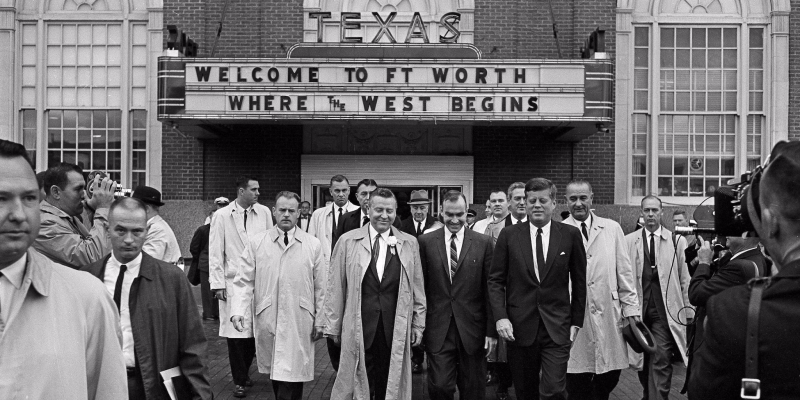
President John F. Kennedy is at the Hotel Texas getting ready for his day. He will give a speech outside the hotel, give a speech to the Chamber of Commerce inside, and then leave Fort Worth for Dallas.
After a motorcade through Dallas and a speech at the Trade Mart, the Kennedy's will travel with the Johnson's to Austin and then to the Johnson Ranch for a weekend of rest.
Kennedy has just picked up The Dallas Morning News. He sees the infamous "black border" ad which accusing him of treason. He also sees a prediction from Richard Nixon that Kennedy will be dropping Johnson from the ticket.
10 a.m.
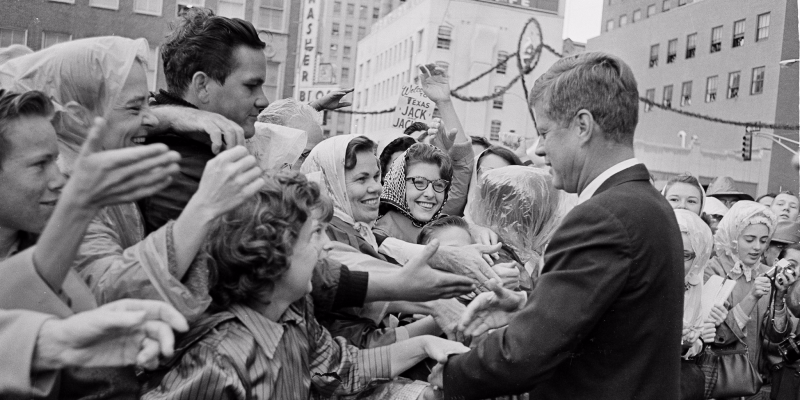
As the weather starts clearing up, advance secret service agent Win Lawson has decided to take the bubbletop off the presidential limo.
Kennedy has made it clear that he wants to be accessible to the people. He wants the bubbletop off as much as possible and does not want secret service agents on the back on his limo.
10:30 a.m.

Kennedy returns to his suite in the Hotel Texas and prepares to leave for Dallas. He remarks to Jackie "you know, last night would have been a hell of a night to assassinate a president" in reference to their late night motorcade through Fort Worth.
11:50 a.m.

Multiple co-workers see Oswald on the first floor of the book depository eating lunch. Simultaneously, the motorcade leaves Love Field to begin the motorcade through Dallas.
12:05 p.m.
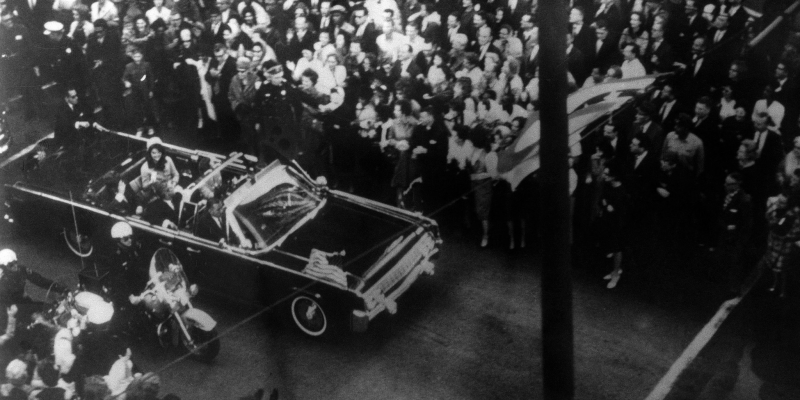
Kennedy makes his first of many stops to shake hands with groups of people waiting to meet him, delaying the motorcade by five minutes.
12:29 p.m.

The president's limo turns onto Elm Street. The first shot is fired, missing the president.
A fragment from the bullet or debris from the street hit James Tauge, who is watching the motorcade in Dealey Plaza.
A man is standing near the Stemmons Freeway sign with an opened umbrella, giving rise to the "umbrella man" conspiracy theory.
12:30 p.m.

The second shot is fired, causing Kennedy to go into Thornburn's position. This is a common neurological response to spinal damage.
The third shot is fired, hitting the president on the back, right side of his head, causing a portion of his head behind his right ear to blow out. Right after the third shot is fired, Sheriff Bill Decker orders Dallas police officers to the railroad tracks behind the fence on the Grassy Knoll.
Oswald gets a Coca Cola from the soda machine in the book depository and starts walking out of the buildings after being stopped briefly by Dallas police officer Marrion Baker. Oswald walks past NBC's Robert MacNeil, who is looking for a phone to call in the shooting.
12:35 p.m.
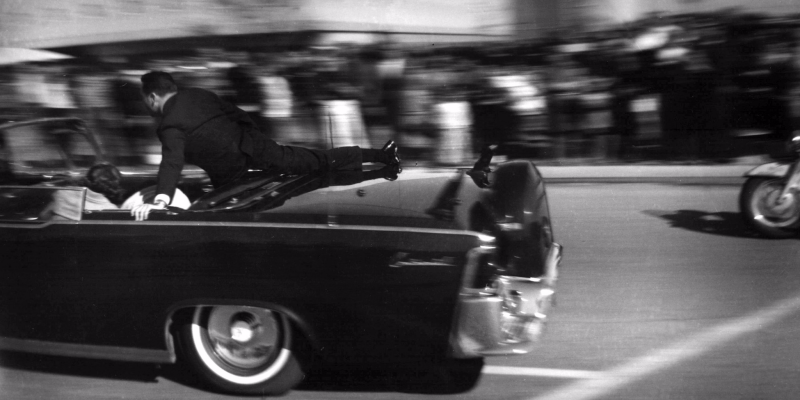
The presidential limo arrives at Parkland Memorial Hospital where "24740, white male" suffering from a gunshot wound is admitted and brought to trauma room 1.
Secret service agent Roy Kellerman, who is in charge in Dallas, calls the head of secret service Jerry Behn to report that JFK has been hit.
Dr. Charles Crenshaw enters and notes there is a large wound on the back of the president's head as well as a small hole in his throat. They use this hole to perform a tracheotomy in order to open up Kennedy's airway.
12:45 p.m.

Oswald gets onto a bus seven blocks from the Texas School Book Depository. The bus isn't moving much because of traffic in Dealey Plaza.
Shortly after boarding, he gets off and gets into a cab driven by William H. Whaley, which he takes back to his boarding house where he changes and gets his pistol.
12:57 p.m.:
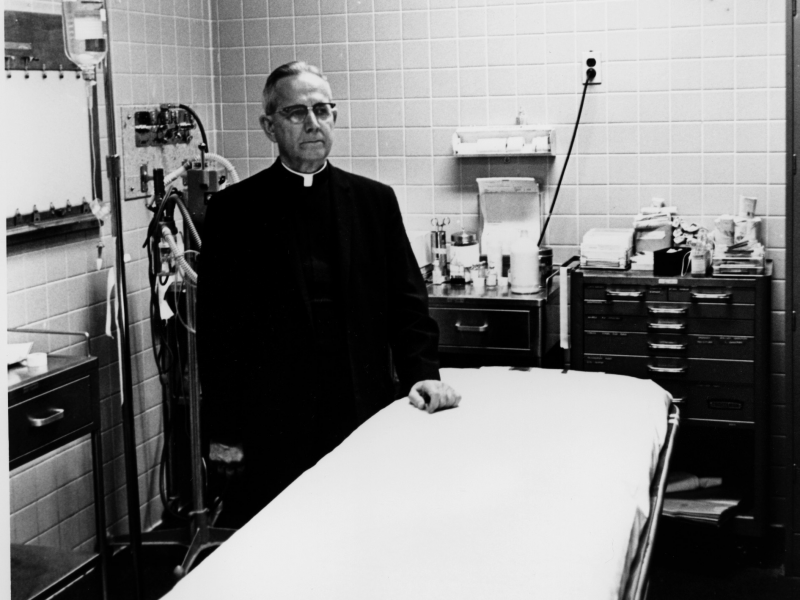
Father Oscar Huber arrives at the hospital. Kennedy aide Ken O'Donnell tells secret service agent Clint Hill to order a casket from somewhere nearby.
The president is already technically dead, but Jackie is worried about him receiving his Catholic last rites before he has died. Just after Huber performs them, Dr. Kemp Clark pronounces Kennedy dead. Admiral Dr. George Burkley officially pronounces Kennedy dead.
1:15 p.m.

After being told to patrol the Oak Cliff section of Dallas, Officer J.D. Tippit speaks to someone who fits Oswald's description. Shortly after, police hear a civilian on the police radio line saying, "It's a police officer. Someone shot him."
1:26 p.m.

Vice President Lyndon B. Johnson leaves Parkland for Air Force One. As he and Mrs. Lady Bird Johnson are leaving, she sees the flags drop to half mast. Assistant White House Press Secretary Mac Kilduff confirms Kennedy's death.
1:40 p.m.

Oswald runs into a movie theater that is playing the film "War is Hell." He is seen sneaking in, and police start to search the theater. The lights are raised and officer Nick McDonald spots Oswald in the seats.
McDonald walks up to Oswald who says, "This is it!" and pulls out a revolver. As they fight, officer McDonald gets his finger in front of the pistol's hammer so the gun will not fire. Oswald punches an officer in the face and the officer punches back, giving Oswald a black eye.
2 p.m.

Secret service agent Roy Kellerman gets into an argument with Dallas Country medical examiner Dr. Earl Rose. The Kennedy party wants his body put in a casket and want to leave the hospital.
At this point, killing a president is not a federal offense. Because of this, the medical examiner argues that the autopsy has to be performed before the body is taken from Dallas. Johnson orders the body to be released, but the ME refuses. Finally, he is overridden by Dallas district attorney Henry Wade, who only agrees to release the body if Admiral Dr. Burkley, Kennedy's private physician, promises to stay with the body until it is put in the casket for the final time.
Simultaneously, Johnson phones grief-stricken Robert Kennedy, the president's younger brother and the Attorney General, to find out what his legal options are about taking the oath of office.
2:07 p.m.

Kennedy's body leaves Parkland Hospital bound for Love Field. After news of the assassination, the stock market has dipped 24 points. It now closes, not to reopen until Tuesday, Nov. 26.
Oswald has arrived at the homicide and robbery office on the third floor of city hall. When asked if he wants to hide his face from reports, he responds, "Why should I? I haven't done anything to be ashamed of."
2:38 p.m.

The president's body has been loaded to Air Force One with much difficulty. The casket they got from the funeral home was too wide for the plane door, and they had to break some of the handles off.
Despite what conspiracy theorists say, the damage to the casket was caused by the secret service, not the casket being opened and the body being altered. Deputy Attorney General Nick Katzenbach spoke to people in Washington to get the correct oath of office.
Despite having trouble reading his writing, he dictates the oath of office and Johnson becomes the 36th president of the United States. He is the first president to be sworn in by a woman, Judge Sarah T. Hughes.
3 p.m.

Oswald's first interrogation has started. The police take paraffin tests of his hands and face to determine if he has fired a gun. The test of the hands comes back positive. They have only charged him with the killing of Officer Tippit. He has not been charged with killing the president yet.
4 p.m.
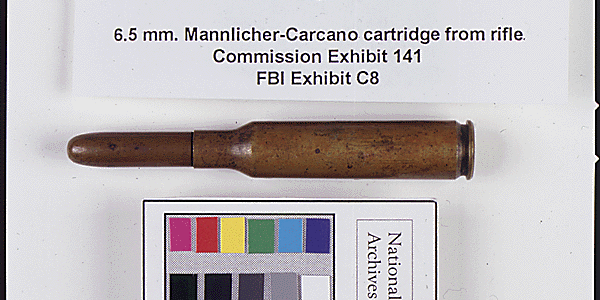
FBI Director J. Edgar Hoover called RFK to tell him "we have the man."
Oswald waits for his first lineup with Helene Markham, the witness to Tippit's murder. While waiting, Oswald is searched and five bullet cartridges are found in his pocket.
Jack Ruby, who owns The Carousel Club, stops by the police station for the first time. Since many of the officers frequent the club, he is familiar with quite a few people and is able to walk around the police station freely.
4:30 p.m.

Doctors from trauma room one fill out forms stating what they observed in the emergency room. The conflicting reports from the doctors leads to confusion and distrust.
Dr. Marion Jenkins says there was a large hole on the right side of Kennedy's head so large, the cerebellum had protruded from the wound.
Dr. James Carrico, the first doctor to enter the trauma room, noted a large wound located in the right occipito-parietal area and one small penetrating wound in the middle of the neck.
Dr. Charles Baxter said the right temporal and occipital bones were missing and the brain was on the table. Dr. Kemp Clark, who pronounced Kennedy dead, noted two external wounds.
Both the cerebral and cerebella tissue were extruding from the wound. Dr. McClelland stated that "the cause of death was due to a massive head and brain injury from a gunshot wound of the left temple." Dr. Marion Jenkins later supported this statement.
6 p.m. ET
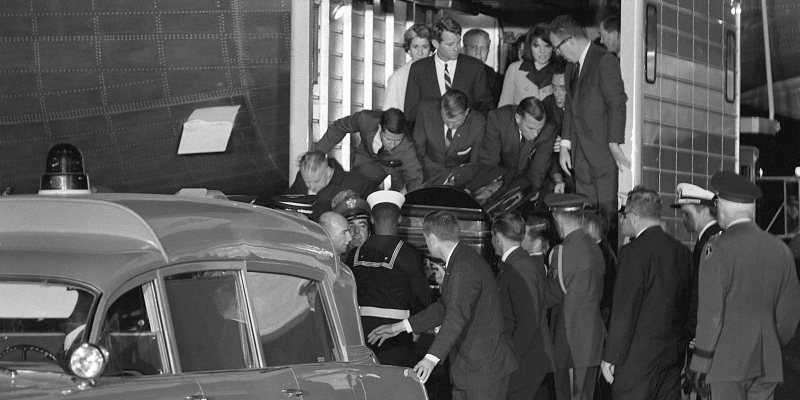
Air Force One arrives at Andrews Air Force Base in Maryland. Among many others, waiting for the plane were Robert Kennedy, Robert McNamara, and General Maxwell Taylor.
Jackie Kennedy has requested that the secret service agents who carried her husband onto the plane as well as "his friends" carry him off the plane. She has also requested that secret service agent and driver Bill Greer drive the ambulance with the coffin to Bethesda Naval Hospital.
Robert Kennedy has rushed onto the plane to find Jackie. He puts his arm around her and quietly says "Hi, Jackie. I'm here."
When they get into the ambulance with the casket, Jackie recounts the motorcade, the shooting, and aftermath in detail to RFK.
Lyndon Johnson makes his first statement on TV as president.
6:20 p.m. CT
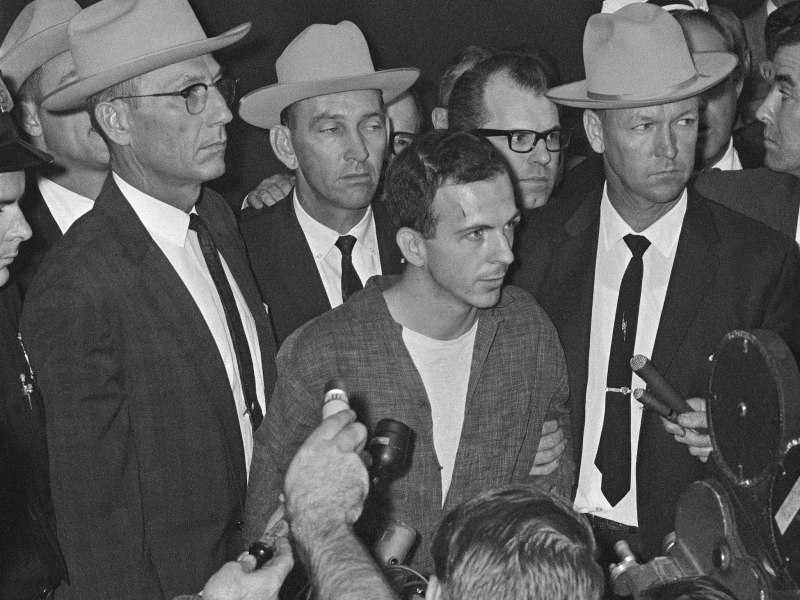
Oswald's second interrogation starts in Captain Fritz's office. At this point, they are still only investigating and interrogating Oswald about the shooting death of Officer Tippit. As he is taken out for his second lineup, Oswald yells to the press, "I didn't shoot anyone!"
Cecil McWatters, the driver of the bus Oswald took from the Texas Book Depository Building, identifies Oswald. McWatters says that Oswald was wearing a jacket, though the Warren Commission (which investigated the assassination) said he was not. Also, later when testifying to the Warren Commission, McWatters says he was wrong in selecting Oswald in the lineup.
7 p.m. ET:

Jackie Kennedy and Robert Kennedy enter Bethesda Naval Hospital. RFK stops to sign the order for the autopsy of his brother. They are taken to a VIP suite on the 17th floor of the hospital while the autopsy is performed.
General Godfrey McHugh has stopped Admiral Calvin Galloway, who has assembled a team to perform the autopsy. McHugh tells Galloway that the autopsy and embalming should be done by his team and that "Mrs. Kennedy doesn't want an undertaker." Galloway responds, "We don't have the facilities. I highly recommend a funeral parlor." When asked if it's possible, he says, "It's not impossible. It's difficult though. And it might be unsatisfactory."
Sargent Shriver, the president's brother-in-law, prepares the White House to receive Kennedy's body and for it to lay in repose. He has covered the building in black bunting and, at the request of Jackie Kennedy, has gotten books and documents so he can make the White House look like it did when Lincoln died and laid in repose in the White House.
7:10 p.m. CT:

Captain Fritz has questioned Marina Oswald, and Ruth and Michael Paine. He has also signed a complaint charging Oswald with the murder of Tippit. He is not formally arraigned for the murder of J.D. Tippit.
FBI agents have been sitting in on the interrogations. In regards to the president's assassination, Gordon Shanklin, the agent in charge of the Dallas office, tells New Orleans Bureau chief Harry Maynor, "Oswald was probably a good suspect, but they have been unable to develop information connecting the rifle with Oswald."
7:50 p.m. CT:

Oswald in interrogated for the third time. He is then taken for his third lineup where is he identified by witness J.D. Davies as the man people saw unloading a pistol as he came across their yard immediately following the Tippit shooting. Immediately following the lineup, Oswald's finger and palm prints are taken on an inkless pad.
9 p.m. CT:

Witness Buell Frazier has his sister come to the homicide and robbery office. They both say they saw Oswald carrying a package with him to the Texas School Book Depository. Oswald is later arrested and brought back in for questioning.
11 p.m. ET:

After it began at 8:15 p.m. under the charge of Commander J.J. Humes, Kennedy's autopsy is concluded. Dr. Humes later states that the autopsy results were that Kennedy was killed by two shots from the rear.
Saturday, November 23, 1963, 1:35 a.m. CT:
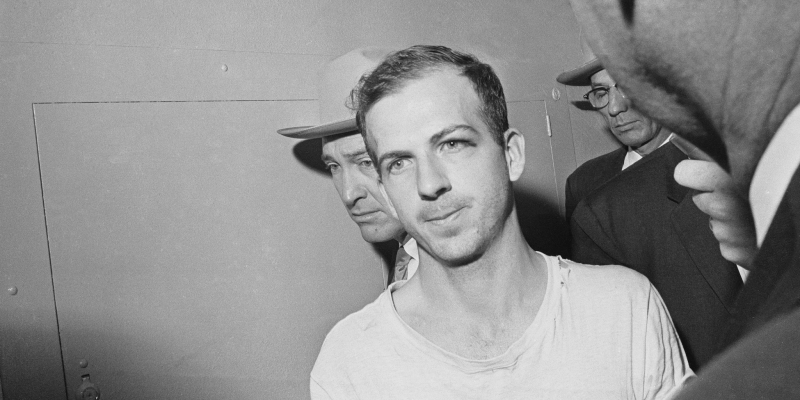
After Captain Fritz signs the complaint charging Oswald with the murder of Kennedy at 11:26 p.m. C.T., Judge David Johnson rules that Oswald "voluntarily and with malice of forethought killed John F. Kennedy by shooting him with a gun."
At 1:35 a.m. C.T., Oswald is officially told he has been charged with Kennedy's murder.
3:56 a.m. ET
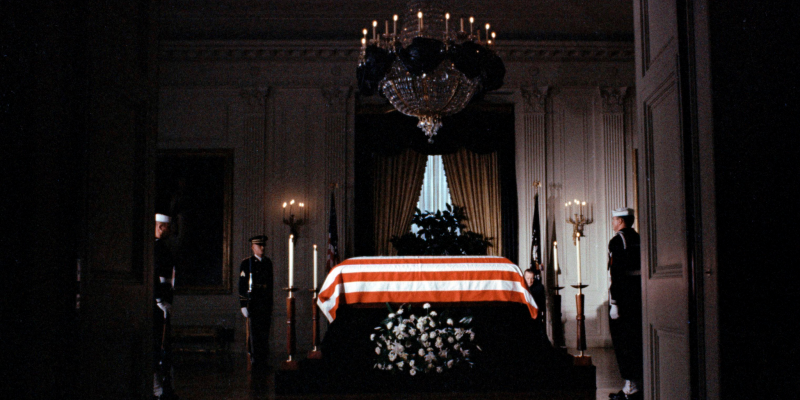
Kennedy's body is brought to the White House, where he will lay in repose until Sunday. On Monday, November 25, son John Jr.'s third birthday, Kennedy will be laid to rest at Arlington National Cemetery.
This timeline comes from Business Insider's Beth Frutkin, who is researching and writing a book on Kennedy. See also her post on the significance of JFK's assassination.
